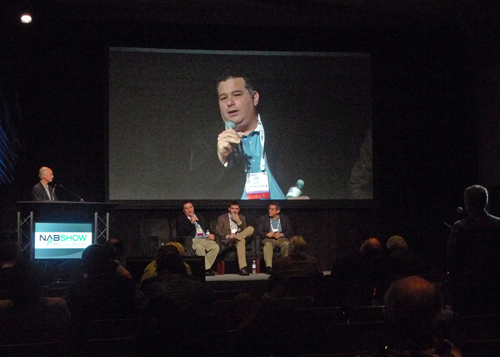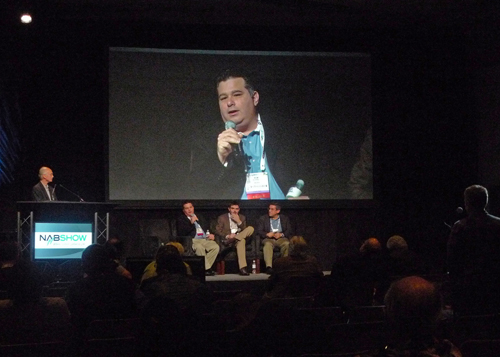NAB Summit on Cinema on Heels of Industry Changes

2012 was a watershed year in the history of cinema. So as the 2013 Summit on Cinema at NAB kicked off Saturday at the Las Vegas Convention Center, there was going to be a lot to process as attendees– having long since graduated from sitting through endless “The Future of Cinema” PowerPoints at trade events– were going to be looking for no-nonsense assessments of last year’s rollouts. Is the digital transition complete? What new technology introductions worked? What didn’t?

In the panel session “Improving Workflow for Digital Cinema
Distribution” Michael Karagosian moderated, as (left to right, seated)
Rob Springer of Cinedigm, Jim Mann of Technicolor, and Craig Seidel of
MovieLabs explored how a theatre– once they’ve already made the
investment in and installed digital DCI-compliant projectors and
servers– can increase profitability by both improving the technical
workflow and getting in new content for new audiences.
At NAB’s Technology Summit on Cinema we learned from Michael Karagosian in his Saturday session “Update on the Digital Cinema Worldwide Rollout” that by the end of 2012, 89,000 digital screens worldwide (36,000 in North America) were digital. (About 50% of the converted screens are 3D.) This push was part of a $5B investment over the past few years, driven by VPF (Virtual Print Fee) subsidies, and the push by Hollywood studios to make theatres 3D-ready.
Karagosian said that there will be increased activity worldwide. For example in Latin America only about 5,000 screens (about half of the total number in the region) are digital. So integrators and gear suppliers in these markets (such as Arts Alliance Media, GDC, Sony Digital Cinema and Telem) could look forward to market growth on pace with what we’ve seen in the U.S. and Europe. The Asia-Pacific region has about 64% conversion; Africa/Middle East has seen only 20% conversion
Karagosian, principal of MKPE Consulting, who has in the past been a top consultant to NATO (National Association of Theatre Owners), and is now an independent consultant and works with top Hollywood studios, SMPTE, and DCI, explained that while the pace of change and conversion has been impressive, there are challenges remaining in any “complete” conversion, and even more challenges ahead as the industry adapts to new business models. It’s well known that although U.S. box office sales of movie tickets has ticked up modestly in the past two years, that increase has been the result of increased ticket prices not more unit sales. And in fact some theatre owners have put a price premium on tickets to 3D showings (this trend is more pronounced outside the U.S.). According to Karagosian, U.S. theatres have, for now, probably hit a kind of wall and won’t be able to raise ticket prices going forward. And those exhibitors are now burdened with higher debt levels resulting from the recent gear upgrades.
What about 4K? That is, higher resolution projection– digital projectors with 4K resolution or beyond (similar resolution to the image capture standards of the best conventional 35mm cameras still used on most big-budget Hollywood shoots). The 4K projection footprint at the end of 2012: about 20,000 projectors out there in commercial movie theatres worldwide are 4K, versus about 70,000 2K resolution projectors. Karagosian explained that there is a “sweet spot” in any individual theatre for high res. You have to be sitting closer to the screen to be able to resolve the added resolution. So any move to 4K in commercial theatres is going to involve only a portion of the market. And Karagosian told me in private conversations at NAB that he will be closely following any further 4K rollout in commercial theatres to lobby that it’s done right– a rollout to large screens only in the next phase.
In commercial movie theatres this year, the emphasis is still on ramping up 3D for tent pole Hollywood rollouts like the Hobbit. And since there is no 4K 3D, 4K is if not a moot point this year with the exhibitors and the public, on the back burner until further 3D and HFR (High Frame Rate) issues play out. So the current snapshot of the market sees any new push to 4K, or even buzz around 4K, taking–unfortunately, in my opinion– a back seat for now.
A daily selection of the top stories for AV integrators, resellers and consultants. Sign up below.
There will be more opportunities to grow and strengthen the cinema market going forward, as theatre operators look at new ways to get efficiency from existing investment. In a separate panel on Saturday “Improving Workflow for Digital Cinema Distribution” Karagosian moderated, as Rob Springer of Cinedigm, Jim Mann of Technicolor, and Craig Seidel of MovieLabs explored how a theatre– once they’ve already made the investment in and installed digital DCI-compliant projectors and servers– can increase profitability by both improving the technical workflow, and getting in new content for new audiences.
Currently, delivery of a DCP to the theatre is typically by satellite, or hard drive, or (very high speed) Internet. The theatre’s KDM (Key Delivery Message) is a “key” to unlock the file (typically delivered by email– it’s just a very long code sequence). But in that process, there are today lots of ways to get the content, get the KDM, and point the DCP to a server in the theater. It’s a hodgepodge of technology– involving fingerprinting, content protections, authorization updates– from different (competing) vendors. And that landscape is still a battleground pitting camps in favor of open standards against proprietary KDM management suppliers.
Rob Springer of Cinedigm made the case that theatre owners need to look at new management models that allow them to show alternative content. With only 5 % of seats occupied in theatres Monday-Friday (15% on a yearly basis), and given big studios’ focus on blockbuster movies (making fewer movies each year and putting all their eggs in the blockbuster basket), Cinedigm thinks that theatre owners have to find new content to fill those seats– live sports broadcasts, concerts, interactive, more indie movies, etc. A more “narrowcasting” approach. Indeed, Cinedigm understands content booking well and has built strength in the U.S. with their TMS (Theatre Management System) software as well as their agility in putting together VPF-funded deals with theatre owners last year.
The panel all agreed that there are many ways to improve efficiency– some of those on the technology side as standards issues play out, and some on the management side as all players learn to better organize delivery protocols. Including, some that have more to do with things like studios’ poorly scheduled UPS pick up of hard drives, than new KDM coding schemes. (That last conclusion based on a question from the audience, from a theatre operator, at the conclusion of the “Improving Workflow for Digital Cinema Distribution” session.) As much as we all love new technology, some things never change. Plowing ahead deeper into 2013, the industry can by no means rest on any laurels, despite huge strides made in 2012.
